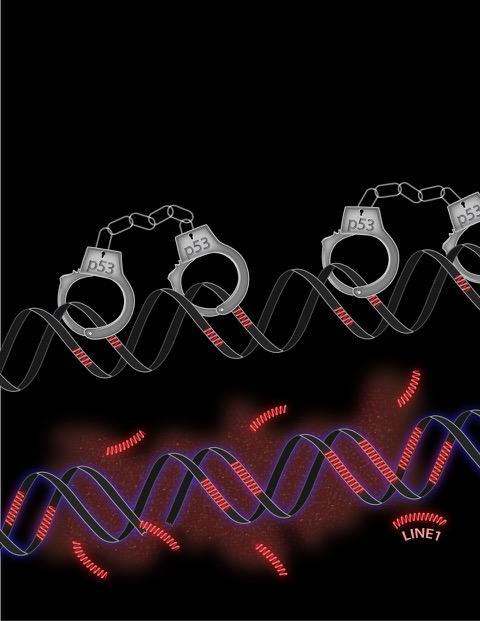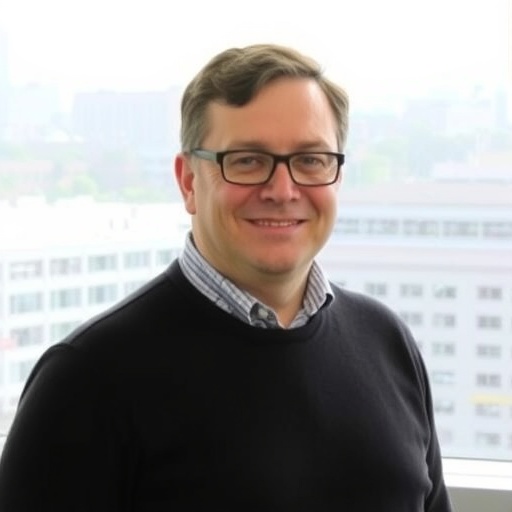Finding sheds light on why mutations of the gene p53 are associated with cancer and could lead to new diagnostics or treatments

Credit: Study authors Amanda Jones and Bhavana Tiwari. Artwork by Angela Diehl.
DALLAS – Oct. 29, 2020 – About half of all tumors have mutations of the gene p53, normally responsible for warding off cancer. Now, UT Southwestern scientists have discovered a new role for p53 in its fight against tumors: preventing retrotransposons, or “jumping genes,” from hopping around the human genome. In cells with missing or mutated p53, the team found, retrotransposons move and multiply more than usual. The finding could lead to new ways of detecting or treating cancers with p53 mutations.
“There’s been long-standing literature associating retrotransposons with cancer,” says John Abrams, Ph.D., professor of cell biology at UTSW and senior author of the study published recently in Genes & Development. “What this work does is deliver the first empirical link between p53 and retrotransposons in humans.”
The role of p53 as an anti-cancer, or tumor suppressor, gene has been well-established. It works by blocking cell growth, or inducing cellular suicide, when cells are under stress or dividing abnormally, as is the case in tumors. But researchers have long wondered whether the gene has another function. Even when the previously known targets of p53 – genes involved in cell growth and death – are removed or mutated, p53 still protects cells from cancer, suggesting additional, unknown targets. Moreover, the gene is found throughout evolution, including in ancient single-celled organisms.
“These genes existed long before the need for blocking cancer,” Abrams says. “My lab has wondered what originally drove the evolution of p53 genes and whether that knowledge can help us target cancer.”
Retrotransposons are stretches of DNA that, after being transcribed into RNA, can insert themselves into new spots in the genome. These mobile genetic elements are considered beneficial to some degree – they can help genes evolve with new functions. However, they also have the potential to shuffle genomes and insert themselves into genes that are critical for cell health and growth, potentially contributing to cancer.
In 2016, Abrams and his colleagues discovered that retrotransposons were especially mobile when p53 was inactivated in cells of flies and fish. In the new work, they set out to study whether the same was true in human cells.
When the researchers used CRISPR-Cas9 gene editing technology to remove p53 from human cells, they found that the abundance of retrotransposons quickly increased. Cells derived from both cancers and normal lung tissue that were engineered to lack p53 had roughly four times the rate of retrotransposon movement than cells still containing p53.
Abrams’ team also introduced a synthetic, fluorescent-tagged retrotransposon to cells that let them follow the movement of the retrotransposon throughout the genome in real time. The results were similar to their first experiment; the retrotransposon was about four times more mobile, and therefore became more prevalent over time when cells lacked p53. The finding hints that one way in which p53 works to prevent cancer is by blocking retrotransposons from leading to other cancer-causing mutations.
“In the clinic, one could use this information to possibly detect or mitigate p53-driven cancers by quantifying or blocking retrotransposon activity,” says Abrams. A liquid biopsy, for instance, could be developed to detect an overabundance of retrotransposons that, theoretically, may precede cancers or be easier to detect than other cancer mutations.
The research team further solidified the link between p53 and retrotransposons by showing that the p53 protein binds directly to one region of human retrotransposons. And they showed that a drug blocking the ability of retrotransposons to copy themselves prevented inflammation otherwise seen in cells with high levels of retrotransposon movement. More work is needed to determine whether a drug targeting retrotransposons could slow or stop the growth of existing cancers.
###
Other UTSW researchers who contributed to this study were co-first authors Bhavana Tiwari and Amanda Jones, as well as Candace Caillet, Simanti Das, and Stephanie Royer.
This research was supported by funds from the Cancer Prevention and Research Institute of Texas (RP170086), the American Cancer Society (128847-PF-15-160-01-DDC), and the National Institutes of Health (R01GM115682 and R01CA222579).
About UT Southwestern Medical Center
UT Southwestern, one of the premier academic medical centers in the nation, integrates pioneering biomedical research with exceptional clinical care and education. The institution’s faculty has received six Nobel Prizes, and includes 25 members of the National Academy of Sciences, 17 members of the National Academy of Medicine, and 14 Howard Hughes Medical Institute Investigators. The full-time faculty of more than 2,500 is responsible for groundbreaking medical advances and is committed to translating science-driven research quickly to new clinical treatments. UT Southwestern physicians provide care in about 80 specialties to more than 105,000 hospitalized patients, nearly 370,000 emergency room cases, and oversee approximately 3 million outpatient visits a year.
Media Contact
UT Southwestern Medical Center
[email protected]




